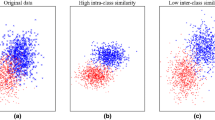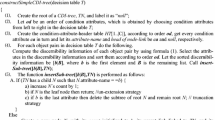Abstract
Tri-level attribute reduction is an interesting topic that aims to reduce the data dimensionality from different levels and granularity perspectives. However, existing research exhibits limitations, mainly in handling symbolic data, lack of effective reduction algorithms, and scarcity of data experiments and performance evaluations, which would be an obstacle to the further development of tri-level attribute reduction in theory and application. Hence, we systematically investigate tri-level attribute reduction based on neighborhood rough sets (NRSs) for numerical data. We first give the class-specific and object-specific attribute reduction conditions based on NRS, respectively. Furthermore, we explore and analyze relationships of tri-level reducts. From the perspective of forward and backward reduction, we propose algorithms of class-specific attribute reduction based on dependency degree, and object-specific reduction algorithms based on inconsistency degree. Finally, we introduce a novel metric to validate the efficiency of specific class and specific object attribute reductions. The results of data experiments show the feasibility and effectiveness of tri-level attribute reduction based on NRS in data analysis.












Similar content being viewed by others
Data Availability
The data for this study are openly available in UCI Machine Learning Repository at https://archive-beta.ics.uci.edu/datasets.
References
Yuan Z, Chen H, Xie P, Zhang P, Liu J, Li T (2021) Attribute reduction methods in fuzzy rough set theory: an overview, comparative experiments, and new directions. Appl Soft Comput 107:107353
Hu Q, Qin K, Yang H, Xue B (2023) A novel approach to attribute reduction and rule acquisition of formal decision context. Appl Intell 53(11):13834–13851
Wu W, Qian Y, Li T, Gu S (2017) On rule acquisition in incomplete multi-scale decision tables. Inf Sci 378:282–302
Wang C, Shi Y, Fan X, Shao M (2019) Attribute reduction based on k-nearest neighborhood rough sets. Int J Approximate Reasoning 106:18–31
Sun L, Wang L, Ding W, Qian Y, Xu J (2020) Neighborhood multi-granulation rough sets-based attribute reduction using lebesgue and entropy measures in incomplete neighborhood decision systems. Knowl-Based Syst 192:105373
Chen Z, Liu K, Yang X, Fujita H (2022) Random sampling accelerator for attribute reduction. Int J Approximate Reasoning 140:75–91
Yang X, Li M, Fujita H, Liu D, Li T (2022) Incremental rough reduction with stable attribute group. Inf Sci 589:283–299
Yao Y (2021) The geometry of three-way decision. Appl Intell 51(9):6298–6325
Yin T, Chen H, Yuan Z, Li T, Liu K (2023) Noise-resistant multilabel fuzzy neighborhood rough sets for feature subset selection. Inf Sci 621:200–226
Yao Y (2016) Three-way decisions and cognitive computing. Cogn Comput 8(4):543–554
Yang J, Zhang X, Qin K (2022) Constructing robust fuzzy rough set models based on three-way decisions. Cogn Comput 14(6):1955–1977
Yang J, Yao Y (2021) A three-way decision based construction of shadowed sets from atanassov intuitionistic fuzzy sets. Inf Sci 577:1–21
Cheng Y, Zhang Q, Wang G, Hu BQ (2020) Optimal scale selection and attribute reduction in multi-scale decision tables based on three-way decision. Inf Sci 541:36–59
Wang J, Ma X, Xu Z, Pedrycz W, Zhan J (2022) A three-way decision method with prospect theory to multi-attribute decision-making and its applications under hesitant fuzzy environments. Appl Soft Comput 126:109283
Jiang C, Guo D, Xu R (2021) Measuring the outcome of movement-based three-way decision using proportional utility functions. Appl Intell, 1–15
Fan M, Luo S, Li J (2023) Network rule extraction under the network formal context based on three-way decision. Appl Intell 53(5):5126–5145
Luo J, Hu M (2023) A bipolar three-way decision model and its application in analyzing incomplete data. Int J Approximate Reasoning 152:94–123
Yao Y (2018) Three-way decision and granular computing. Int J Approximate Reasoning 103:107–123
Yao Y (2020) Tri-level thinking: models of three-way decision. Int J Mach Learn Cybern 11(5):947–959
Yao J, Vasilakos AV, Pedrycz W (2013) Granular computing: perspectives and challenges. IEEE Trans Cybern 43(6):1977–1989
Pedrycz W (2018) Granular computing: analysis and design of intelligent systems, 01–289
Yao Y, Yang J (2022) Granular rough sets and granular shadowed sets: three-way approximations in pawlak approximation spaces. Int J Approximate Reasoning 142:231–247
Zhang X, Miao D (2017) Three-layer granular structures and three-way informational measures of a decision table. Inf Sci 412:67–86
Zhang X, Yao Y (2022) Tri-level attribute reduction in rough set theory. Expert Syst Appl 190:116187
Hu Q, Yu D, Liu J, Wu C (2008) Neighborhood rough set based heterogeneous feature subset selection. Inf Sci 178(18):3577–3594
Yang T, Li Q, Zhou B (2013) Related family: a new method for attribute reduction of covering information systems. Inf Sci 228:175–191
Sun L, Wang L, Xu J, Zhang S (2019) A neighborhood rough sets-based attribute reduction method using lebesgue and entropy measures. Entropy 21(2):138
Hu M, Tsang E, Guo Y, Chen D, Xu W (2021) A novel approach to attribute reduction based on weighted neighborhood rough sets. Knowl-Based Syst 220:106908
Jiang J, Zhang X, Yang J (2023) Unsupervised feature selection based on incremental forward iterative laplacian score. Artif Intell Rev 56(5):4077–4112
Jiang Z, Liu K, Yang X, Yu H, Fujita H, Qian Y (2020) Accelerator for supervised neighborhood based attribute reduction. Int J Approximate Reasoning 119:122–150
Zhang X, Tang X, Yang J, Lv Z (2020) Quantitative three-way class-specific attribute reducts based on region preservations. Int J Approximate Reasoning 117:96–121
Ma X, Zhao XR (2019) Cost-sensitive three-way class-specific attribute reduction. Int J Approximate Reasoning 105:153–174
Ma X (2021) Fuzzy entropies for class-specific and classification-based attribute reducts in three-way probabilistic rough set models. Int J Mach Learn Cybern 12(2):433–457
Yao Y, Zhang X (2017) Class-specific attribute reducts in rough set theory. Inf Sci 418:601–618
Ma X, Yao Y (2018) Three-way decision perspectives on class-specific attribute reducts. Inf Sci 450:227–245
Zhang X, Yao H, Lv Z, Miao D (2021) Class-specific information measures and attribute reducts for hierarchy and systematicness. Inf Sci 563:196–225
Chu X, Sun B, Li X, Han K, Wu J, Zhang Y, Huang Q (2020) Neighborhood rough set-based three-way clustering considering attribute correlations: an approach to classification of potential gout groups. Inf Sci 535:28–41
Chen H, Li T, Fan X, Luo C (2019) Feature selection for imbalanced data based on neighborhood rough sets. Inf Sci 483:1–20
Yin T, Chen H, Wan J, Zhang P, Horng S-J, Li T (2024) Exploiting feature multi-correlations for multilabel feature selection in robust multi-neighborhood fuzzy \(\beta \) covering space. Inf Fusion 104:102150
Meng X, Yang J, Liu T, Wu D (2022) Interval-value replacement-based neighborhood rough set model in incomplete fuzzy information systems. In: 2022 IEEE 8th international conference on cloud computing and intelligent systems (CCIS). IEEE, pp 102–108
Zhang X, Yuan Z, Miao D (2023) Outlier detection using three-way neighborhood characteristic regions and corresponding fusion measurement. IEEE Trans Knowl Data Eng, 1–14. https://doi.org/10.1109/TKDE.2023.3312108
Hu Q, Zhao H, Yu D (2008) Efficient symbolic and numerical attribute reduction with neighborhood rough sets. Pattern Recognit Artif Intell 21(6):732–738
Pawlak Z (1991) Rough sets: theoretical aspects of reasoning about data 9:01–30
Zhang X, Yang J, Tang L (2020) Three-way class-specific attribute reducts from the information viewpoint. Inf Sci 507:840–872
Yang X, Chen H, Li T, Wan J, Sang B (2021) Neighborhood rough sets with distance metric learning for feature selection. Knowl-Based Syst 224:107076
Ma X, Yao Y (2019) Min-max attribute-object bireducts: on unifying models of reducts in rough set theory. Inf Sci 501:68–83
Xu J, Zhou C, Xu S, Zhang L, Han Z (2023) Feature selection based on multi-perspective entropy of mixing uncertainty measure in variable-granularity rough set. Appl Intell 54:147–168
Thuy N, Wongthanavasu S (2021) A novel feature selection method for high-dimensional mixed decision tables. IEEE Trans Neural Netw Learn Syst 33(7):3024–3037
Chen Y, Zhang Z, Zheng J, Ma Y, Xue Y (2017) Gene selection for tumor classification using neighborhood rough sets and entropy measures. J Biomed Inform 67:59–68
Sun L, Wang L, Ding W, Qian Y, Xu J (2020) Feature selection using fuzzy neighborhood entropy-based uncertainty measures for fuzzy neighborhood multigranulation rough sets. IEEE Trans Fuzzy Syst 29(1):19–33
Acknowledgements
This work is supported by the National Natural Science Foundation of China (62206228), the Sichuan Science and Technology Program of China (2021YJ0085), the Natural Science Foundation of Sichuan Province (2022NSFSC0929), and the Humanities and Social Science Fund of Ministry of Education of China (23YJA630114).
Author information
Authors and Affiliations
Contributions
All authors have participated in all tasks leading to the development of this paper.
Corresponding author
Ethics declarations
Competing interests
The authors declare that they have no conflicts of interest.
Additional information
Publisher's Note
Springer Nature remains neutral with regard to jurisdictional claims in published maps and institutional affiliations.
Rights and permissions
Springer Nature or its licensor (e.g. a society or other partner) holds exclusive rights to this article under a publishing agreement with the author(s) or other rightsholder(s); author self-archiving of the accepted manuscript version of this article is solely governed by the terms of such publishing agreement and applicable law.
About this article
Cite this article
Luo, L., Yang, J., Zhang, X. et al. Tri-level attribute reduction based on neighborhood rough sets. Appl Intell 54, 3786–3807 (2024). https://doi.org/10.1007/s10489-024-05361-w
Accepted:
Published:
Issue Date:
DOI: https://doi.org/10.1007/s10489-024-05361-w




